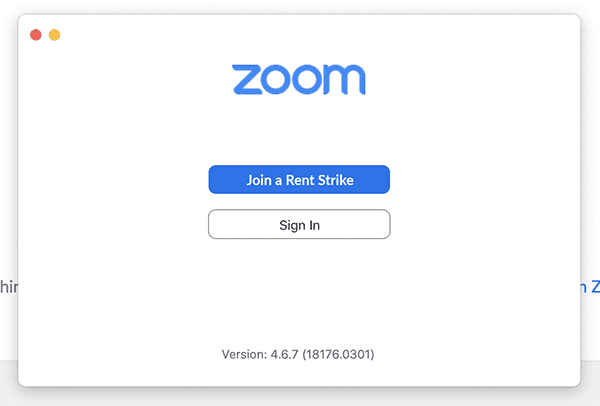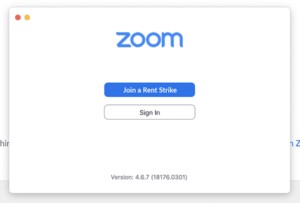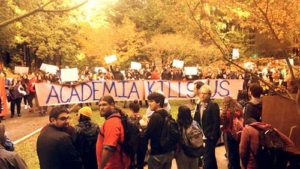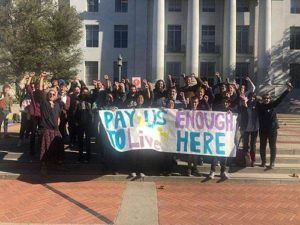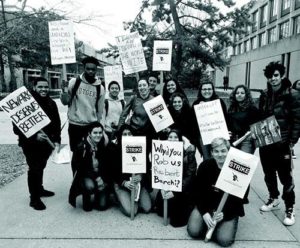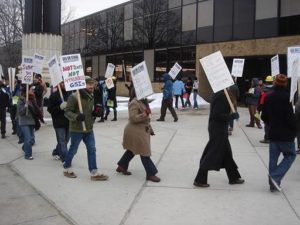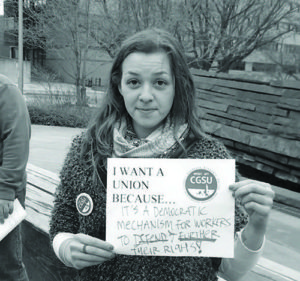COVID-19 Residential Closures and Mass Eviction
The pandemic has shown students what communities being gentrified have known for a long time: in most cities, the university is first and foremost a landlord.
This month, as universities shift to remote instruction, university housing across the US has shut down. Students have been—depending on your perspective—either evacuated or evicted.
Housing policies in a pandemic aren’t uniform, and many schools are sending mixed messages that change from day to day. A few schools have allowed residential students to remain while adopting social distancing measures, such as LIU or UW. Others have closed all housing for students, including graduate students (among them Amherst, Williams, Harvard, MIT, UPenn, and the Pratt Institute). Some (such as NYU, Columbia, RISD) have constructed an ad-hoc system of granting extensions or exceptions to those with extenuating circumstances. In practice, meeting this “high bar” can be difficult: many people who would have to return to unsafe or abusive homes or who cannot travel because of financial difficulties or immigration restrictions, are still forced to leave campus. Many people cannot go home because these are their homes.
Students have coped as best they can: they go home, they go to a friend of a friend, they find an emergency rental, they live in a studio or a storage unit. Many must choose between double rent or homelessness. Students have turned to crowdfunding to support themselves in navigating the expensive and stressful process of moving out and finding housing. Some universities, like Brown, have stopped paying student workers, and the few that have made emergency funds available often finance them not from their own budgets but from fresh appeals for donations from alumni and even other students.
Universities justify these measures by drawing on a sense of emergency, but one thing is clear: these decisions are not motivated by public health, but by the desire to minimize the university’s liability. The public health benefits are uncertain: one epidemiologist stresses that the evacuation of dorms “makes no epidemiological sense… Students with infections can be isolated, they can be monitored.” While universities are rightly concerned about their ability to care for student health in a pandemic, forcing them to return home simply offsets these risks onto communities.
It is hard to imagine other communities being evicted en masse from their homes. In fact, the sudden closure of student housing in the US and the ensuing mass displacement is without parallel anywhere else in the world, with the partial exceptions of Canada and Costa Rica. In other hard-hit countries such as China, Iran, Italy or Spain, even as universities shut down, students were allowed to remain in university housing (usually under new protocols designed to prevent or mitigate COVID-19 spread). In practice, students who can go home tend to do so voluntarily, while those who stay must usually follow some form of social distancing or quarantine.
Even as universities invoke public health concerns, as dorms may be repurposed as overflow medical beds for overwhelmed hospitals, the closure of dorms to students has introduced new health risks. Take, for example, the rehousing process. New School RAs are now living two-to-a-room, and some Columbia University undergraduates have been rehoused from suites to corridors. For students who face travel restrictions, abusive or unsafe homes, and financial hardship, this mass eviction threatens homelessness, financial ruin, emotional collapse, and physical danger. Around half of college students face some kind of housing insecurity, and one sixth have experienced homelessness.
The panic caused by administrators’ lurching responses has made one thing clearer than ever: for those fully reliant on university housing, they are tenants without tenants’ rights. Although they pay rent for shelter, student renters are not shielded by ordinary protections from landlord abuses. Dormitory residents typically aren’t classified as tenants but as licensees: they are borrowing the use of housing for the semester. While licensees have some rights in the US, these rights include no protection from eviction. This is not an outlandish idea: in other countries like the UK, they do.
Why Isn’t Student Housing Affordable Housing?
Securing rights, while important, does not fix the underlying economic problems of university real estate. Graduate student workers, like faculty and staff, for example, usually are classified as tenants—likely why some universities did not evict them in some cases. Even for those who have not been evicted, it’s not clear how we will continue to pay rent, particularly in the summer months when graduate student funding usually dries up and we now may not be able to leave cities on lockdown. This crisis has only made visible how rent-burdened student workers are, including those in “subsidized housing,” a point driven home by recent wildcat strikes for a cost-of-living adjustment (COLA) in the UC system, where 78% of graduate student workers are rent-burdened.
Many graduate student workers mail most of their paycheck back to the university as rent. The whole system recalls the “company store”, where worker’s pay flows back to the employer who has a quasi-monopoly over necessities at inflated prices. If you compare student housing to other individually-owned properties nearby, let alone to housing costs before the university purchased the neighborhood, it is often the least affordable option. However, for students coming to the university from far away and uncertain of how to navigate the local real estate market, it is often presented as the most convenient or even the only option. The result is that students are at the mercy of universities. While this means that all students are liable to face housing insecurity individually, collectively this insecurity only becomes visible at moments of crisis.
There are many solutions for student housing insecurity that do not drive gentrification, such as an off-campus rental subsidy, or a cost-of-living-adjustment. But when universities start to function like real estate companies that run a school for the tax benefits, the university script is to justify land grabs by appealing to the public good, then betray the public good by on the grounds of student welfare, and then extort student tenants and student workers to finance further expansion.
We are graduate student workers at Columbia University, a textbook example of how the idea of education is used as cover for a dual process of exploitation and expropriation. Columbia is the seventh-largest property owner in NYC by square footage, and second-largest by number of addresses, after only the city itself. It pays limited property taxes on its commercial, residential and vacant holdings due to its exempt-status as a not-for-profit institution. Although the university contributes to the community and local services through a negligible PILOT (or Payment In Lieu Of Taxes) contribution and the Community Benefits Agreement, both of these programs depend as much on the good will of university administrators as its needs to improve its public image. Columbia’s $150 million CBA, for example, expires in 2040, when construction on the Manhattanville campus is projected to end. The high rents that the University charges on its residential holdings remain inordinately profitable for the institution, while seeming to have little overall community benefit.
In one egregious example of university expropriation, Columbia secured state approval to use eminent domain to seize private property in West Harlem to develop the new Manhattanville campus, without the owners’ consent, for the “public good.” At another address on the new campus, 600 W 125 St, Columbia University promised to provide space to rehouse a community school, but has since backtracked with the DOE’s approval and against community wishes. The university now plans to build student and faculty housing at the location, and will no doubt promote its units as “subsidized,” even as prices remain above market rates.
In fact, benefits to its targeted population–faculty and graduate students in eligible programs–are fleeting. Claims of “subsidized” housing are based on the university’s own calculated rent prices. Considering the university’s ownership of neighborhood housing stock, these claims are, in effect, an accounting device given that they provide no direct, recognizable allowance to offset the steep cost of living in their buildings. Of course, priority consideration for local housing isn’t offered to all university workers.
In this regard, claims of subsidies in university housing are designed to divide student tenants from non-affiliated tenants in the neighborhood, with the promise of higher quality housing, lower rent, and a short commute. In fact, the expansion of student housing creates the conditions for a rise in rental costs throughout the neighborhood, the displacement of working-class Black and Latinx residents, and the acceleration of gentrification in the city. In the process, it actively undermines possibilities for building community and solidarity.
The University Landlord and the Student Tenant
In the US, the increase in housing, healthcare, and education costs has far outpaced any other category of expenses. Economists explain this in terms of the tendency of the cost of services to increase relative to goods over time, yet that doesn’t explain the persistent demand in these categories. Housing, healthcare, and education: where we live, how we stay alive, and how we secure a livelihood. Rather than being protected as rights, these essential needs are priced at whatever the market will bear. The private university has premised its profit model on this state of affairs.
The university plays many roles in relation to those who depend on it: employer, creditor, landlord, hospital, school, and so on. A university landlord will take not just your debt-financed tuition, but also your rent money and—if it also runs a hospital system, as Columbia does—your medical insurance too.
While student employee unions in private universities have staked out a position for students as workers, we need to bind this to our struggles as tenants, debtors, and patients. This should open up new avenues for solidarity: for example, with the un- and uninsured or medically indebted, with unaffiliated neighbors in our buildings, with unhoused people in our communities, and with commercial tenants in university properties.
The coronavirus crisis shows that in a world in which education, like all the other necessities of life, is a commodity, we must organize as consumers, not just producers. It is up to us to imagine and organize towards a collective action that reflects the interlinked realities of work, tuition, debt, and rent. Among other things, that means fighting for affordable housing, tenant rights, and an end to gentrification right now. A rent strike is a good place to start.

